Make work pants work for you.
How to know what makes the flat front classic your most wearable pant ever, with the next installment of POMs, fabric & construction info, & entirely 2 much style inspo.
Above from left: Eliza Dushku in Bring it On (2000), Johnny Knoxville in L.A., (2013), Zoe Kravitz in High Fidelity (2020), Avril Lavigne in concert, (2002), Tyler the Creator (2022)
I’m from the west coast and came of age in the early ‘00s, so you cannot expect me to not have been deeply influenced by skate culture in its prime. And while you may be thinking “do you even skate bro”—which you would be correct in this assumption that no, I do and did not skate, the cultural vibes of west coast skaters was a significant reference for my personal style development. And boy, did work pants reign supreme amongst skater boys in the suburbs of Portland, Oregon.
It is my opinion that true personal style transcends and reinvents the original belonging of the garment—i.e. Julian Casablancas in his heyday continually wearing a vintage military jacket—was he a veteran or even, for that matter, pro-war lol? No, and it didn’t even matter because every guy and his mother wanted to cop a military jacket after Julian did so. Through irony and being extremely, for lack of a better word, cool, Julian reinvented the antique style military-wear into his own look. Of course Julian wasn’t the first to convert a military jacket into his own look—Prince comes to mind—but I use Julian as an example of a more casual and accessible style for the everyday. Prince was too much of an ethereal being whose style was so original & avant-garde that the general public knew it was futile to try and emulate him.
Similar to the specified role attached to a military garment, a clothing item is often enmeshed within a gender role. Work pants and, more generally, skate style, were dominated by men. But just as above where the boundaries of what a garment is “worn for” are pushed, the same is true for style inspiration across genders. When it comes to receiving influence from a gender other than your own, Keke Palmer put it best when she said in regards to Usher as a performer: “I know I’m a gUrL but when I watched your videos, I never wanted to be the girl in them, I wanted to be YOU.” I feel the same about having always wanted to be the cool skater boy on a style level!
So now that you know you don’t have to be a skater to dress like one, what is a work pant anyway? For all intents and purposes, I’m grouping work pants under medium to heavyweight twill or canvas fabric, with a flat front (no pleats) and extensive topstitching, and a long rise/dropped crotch. I’ve included pant styles which feature a hammer loop—more specifically a painter pant—but that falls under work pants by definition. I think the most classically understood work pant is a retro Dickies, like the kind Johnny Knoxville used to wear (another original style inspiration for every gender it seems)—he was the work pant king in the ‘00s.
Above: Johnny Knoxville rocking most likely Dickies all the time, everywhere
Above: Paul Mescal loves work pants, too
Above: Zoe Kravitz in chocolate brown pants + her The Row boots (love to see a celeb repeat items)!
Working to find the perfect work pant…
As always, where and when the garment is made matters. Sadly most work pant brands are no longer made in the USA and the fit can be totally off. And since CRACD is about ethical labor practices, locally made and sustainable, I’d say look for Dickies’, Carhartt, and Ben Davis all VINTAGE when searching on eBay, etc. As for USA newly-made, Round House actually does a great rigid denim & canvas version of a classic straight leg painter pant (linked below). Another note is to make sure the fabric doesn’t have stretch! For work pants, I think a poly/cotton blend is fine and somewhat typical because it’s more durable and crease-free than 100% cotton. But I’m always personally going to gravitate to a 100% cotton pant because of my sensitive skin :). And if you’re buying new, don’t be afraid to wash and wear in the fabric—it may be stiff at first but it will be worth the work for your work pant.
Above looks: #1: vintage Ben Davis work pant w/ thrifted L.L. Bean embroidered cardigan & MEDEA handbag; #2: Stan Ray “fat pant” w/ thrifted silk top, Marni belt & Officine Creative suede handbag
Fit with points of measurement guide.
There’s some overlap with jeans and chinos but the desired fit for a work pant tends to have a much longer rise / dropped crotch, and they usually sit lower on the waist. I’ve measured my vintage Ben Davis work pants for reference with some POMs (points of measure) to help you find your best work pant. As always, having a garment with a fit you like to compare other measurements to, or to use as a reference point, is super helpful when shopping.
Just like last POMs exercise with jackets, you will need to identify your desired fit. And always measure garments completely flattened and fastened, i.e. zipped or buttoned up all the way. Again, it is very helpful to know your body measurements.
Above looks: #3: Stan Ray painter pant w/ thrifted Woolrich rain jacket & Marsèll suede boots, #4: Marc Jacobs carpenter pant w/ second hand Isa Arfen crochet wool sweater & Villeine wallet chain w/ accompanying charms
Waist: measure pulling the front and back waist up to meet each other and follow the curve—this one is almost a 3-point measurement: 1-left edge of waist, 2-center front, 3-right edge of waist. Circumference measurements are obviously doubled to get the total waist.
Hip: I like to measure this one 5” down from top of waist at center front straight across. Circumference measurements are obviously doubled to get the total hip.
Inseam: simplest measurement! Just follow from crotch point straight down to leg opening along the literal insteam.
Front rise: Lay the pant with the back legs facing each other like they were folded in a store and pull the rise seam out as flat as possible. Measure from top of waist.
Back rise: Lay the pant with the front legs facing each other like they were folded in a store and pull the back rise seam out as flat as possible. Measure from top of waist.
Thigh: measure 1” down from crotch point straight across. Circumference measurements are obviously doubled to get the total thigh.
Leg opening: this one is less for fit and more for design. Measure straight across and double it for total leg opening.
Just like last time with jackets, please note that if you do not have a reference garment when measuring and you are going solely off your body measurements, you will need to add at least an 1” of ease to every measurement from body—>garment. So if your waist measures 27”, you will want the pant to measure at least 28”. And again like before, your desired fit will determine how much ease you want. This is especially true for the rise—the more dropped the crotch, the greater you’ll want the measurement to be.
The fit and the styling go hand & hand when talking pants so I just have to say: if you’re wearing a lower rise pant like I am in looks #1 & #4, avoid wearing too long of a top if the top is fitted—it just looks bad in my opinion and creates a tubby effect. Go for something cropped on top or fitted like a rib knit. OR scratch something small / fitted on top altogether, and go double oversized: big t-shirt, big pants (like Zoe in her hoodie above). Any of these are a great solution to the weird proportions of dropped crotch, low rise pants with a long, fitted top.
Marc Jacobs made in Italy oversized work carpenter pant same as mine $173
Vintage 1960s made in USA Ben Davis work pant waist 28” $130
Stan Ray “Fat Pant” same as mine made in Turkey cotton sateen $126
While it was fun to pull from my entire closet now that I have a home again (I’m living in Clinton Hill, Brooklyn and very much not all moved in yet)—it was almost as though having less constraints on my wardrobe made the styling process MORE complicated. Funny how that works.
See you next week xo Hannah


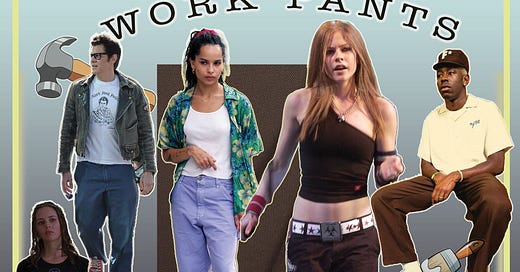



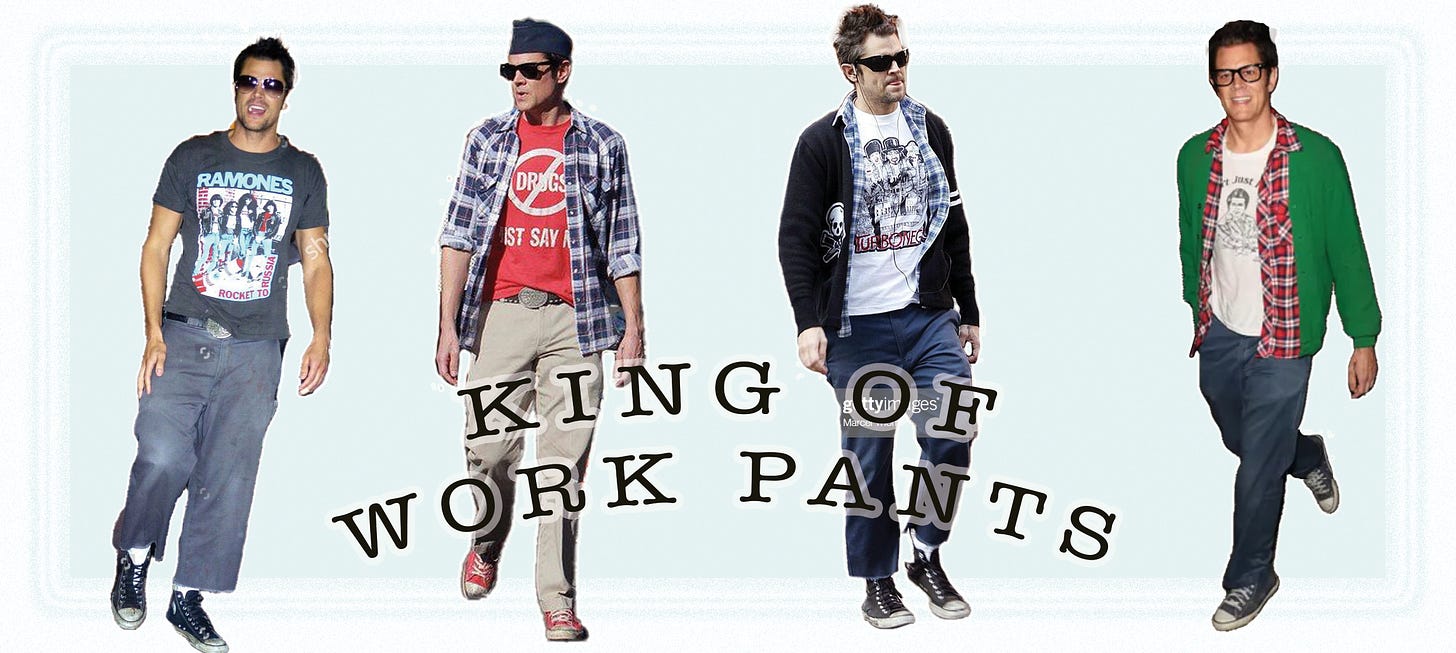



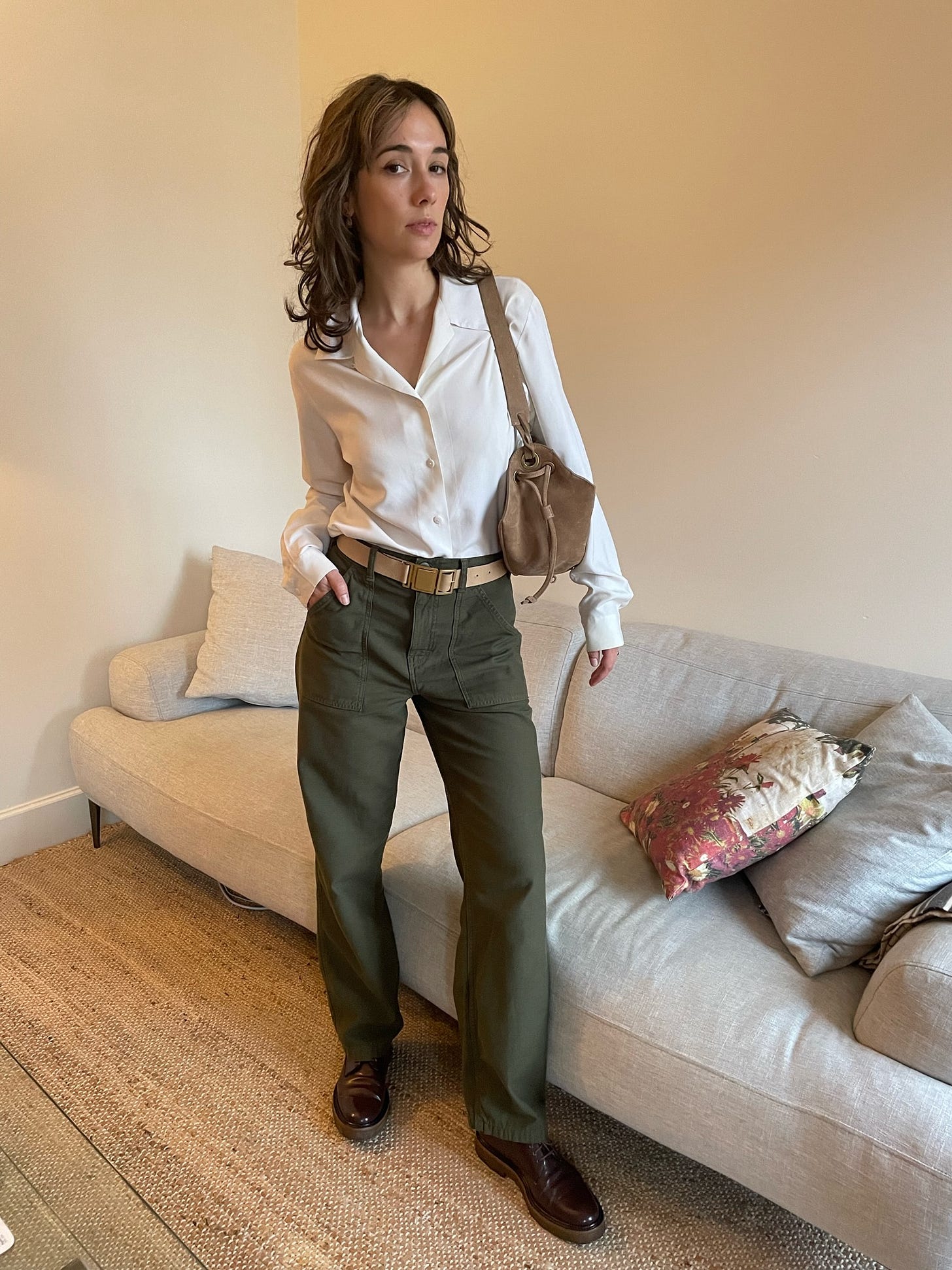
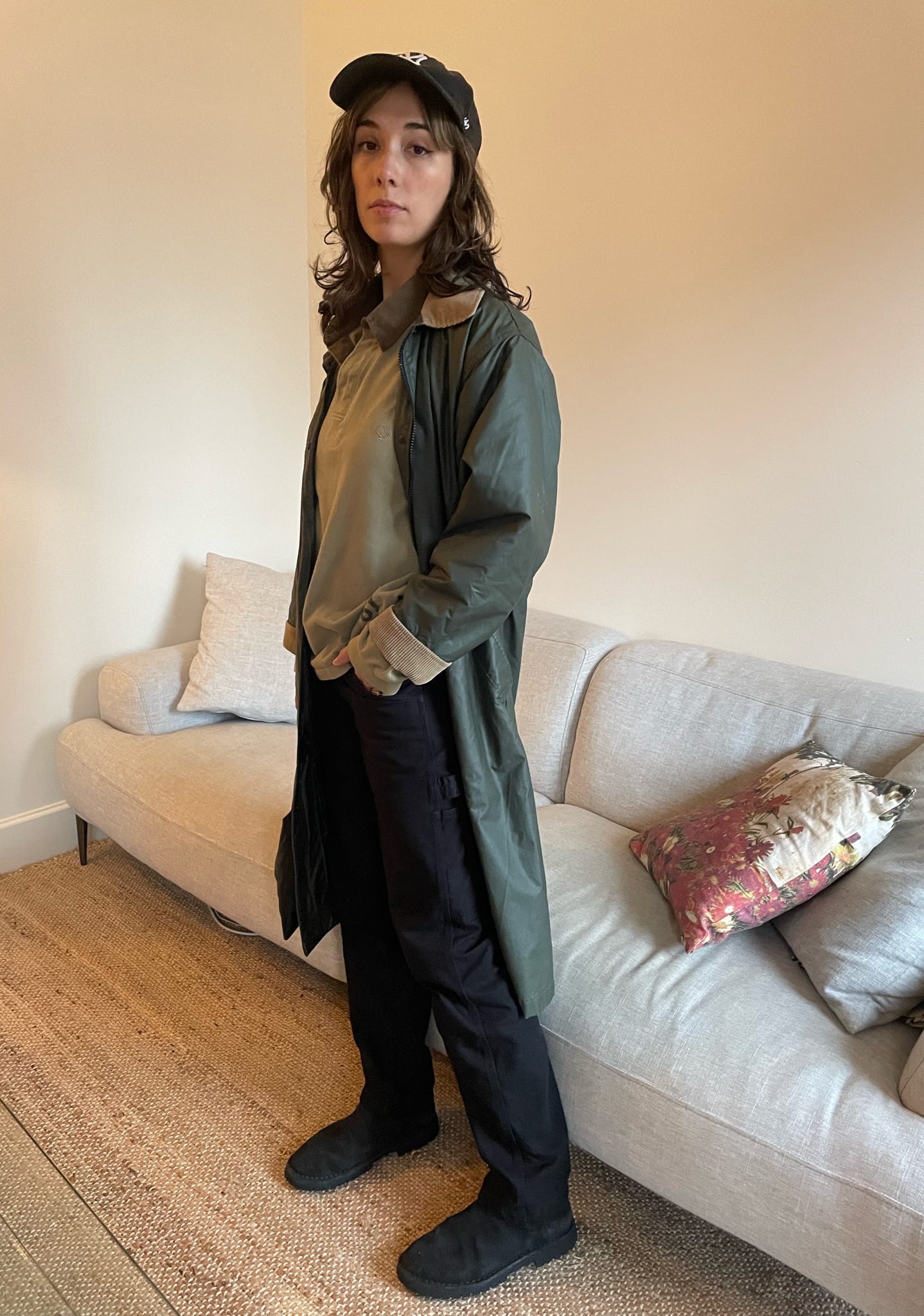

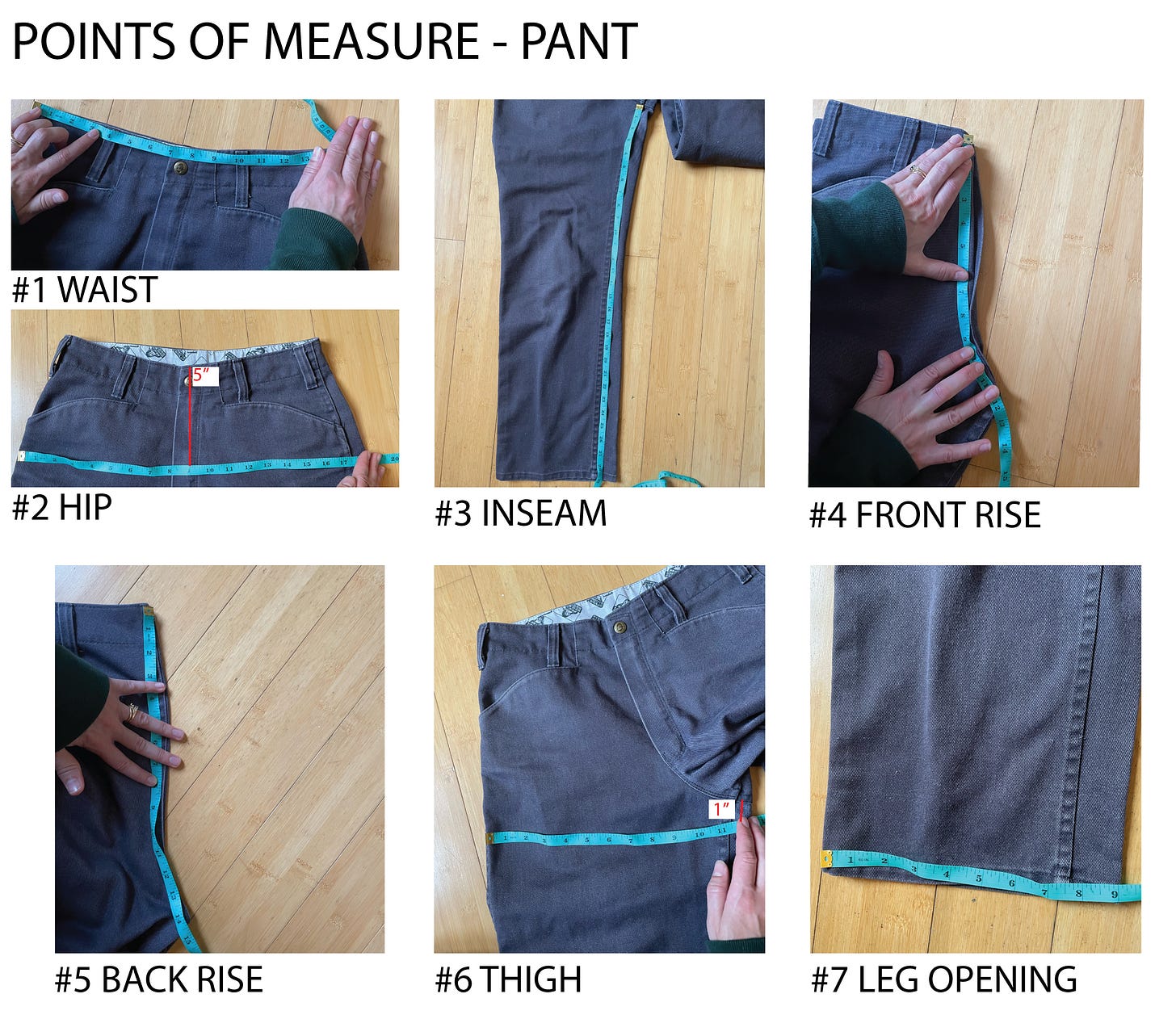

Thanks for demonstrating the way to take proper measurements—very helpful!